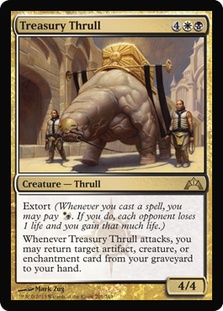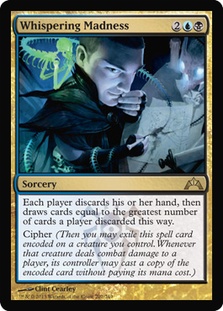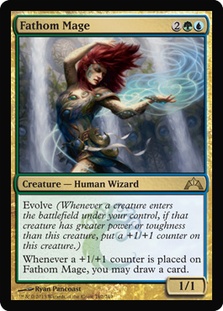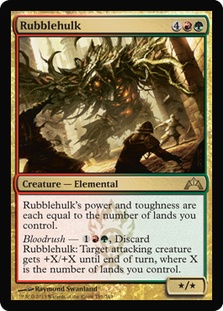We now know all of the guild mechanics in Gatecrash. All of them seem to be to be built very strongly around the specific kind of play pattern that they encourage much more than the original Ravnica mechanics were. What, for example, does radiate have to do with an army? Yes, in the case of certain spells, it worked better when you had a lot of creatures it could target, but overall I’d say it was far too spell based for the guild that represents Ravnica’s military.
Today I want to try to guess what playing with these mechanics will be like, even knowing very few of the cards that have them, and look specifically at how this means the guilds should interact. Ideally, this will help frame what you should be looking for the guilds to do as you go forward in analyzing new cards and thinking about how to play the new guilds, especially in Limited.
I will assume familiarity with the rules text of the new mechanics because I can’t imagine anyone would read an article like this before scouring every possible preview card. If you only read my articles, I don’t mean any offense and am flattered, but you should go check out the preview cards because they’re sweet.
Extort
The Orzhov mechanic is extort. My first reaction when I saw this mechanic was, "This is awesome. If I establish control, this provides a great source of inevitability. Once I have several cards with extort in play, I can just start doming my opponent with a Lightning Helix every time I cast a spell." My second thought was, "Wow, that’s going to be really hard to do against these other mechanics."
Seriously, your plan is to sit behind some Walls against a player whose creatures all get insane if they attack with three of them? Hope you have some pretty good Ghostly Prison variants. Or are we planning to shut down a bunch of 2/1s with a 1/4? How’s that going to work when all of their creatures are also pump spells? And what about Simic? You want to gain small amounts of life while all of their creatures grow every time they play another creature? Good plan, I’m sure they’ll never overwhelm you.
I love the grindy Agent of Masks, Orzhova, the Church of Deals style B/W Control decks and am sure there will be a way to draft that kind of thing, but realistically I just don’t think that’s what extort is going to lend itself best to in this particular set.
That’s not to say it’s going to be bad, I just think there’s a very good chance that B/W will actually be one of the most aggressive, tempo-oriented guilds. I don’t want to give you the impression that you can’t block against Gruul. It’s fine to throw away a guy to make them use a guy as a pump spell. The three mana it seems to cost to do that will stop them from getting too far ahead on tempo, but it still isn’t necessarily the best plan A.
But if your plan is to play cheap, evasive guys, race their slightly bigger guys, and then start draining them for one or two every turn in the midgame, you’re likely to find yourself in a pretty good position to win some races. If you’re playing against a control deck instead of another aggro deck, even better—your deck suddenly has a lot of reach. If their plan is to play some bigger guys to invalidate your small attackers but they’re down to five, they’re going to have to find a way to turn things around pretty quickly or you’ll just drain them out.
I obviously don’t know yet if this format will feel fast or slow, but I do know that it looks very strongly focused on being aggressive. Dimir and Boros have mechanics that specifically only work when you’re attacking, and Gruul and pump spells are both far better known for being used on offense than defense. Simic looks to be the guild that’s happiest to just sit back and do its thing without attacking for a while. At first glance Orzhov can seem similar, but I’m guessing that in this format Orzhov will feel like Izzet felt to me in the last format. It may look controlling on the surface, but the way to win with it is going to be all about early aggression followed by tricky finishers to steal wins as your opponent tries to stabilize.
Cipher
Dimir has a "spell mechanic" again, but while it’s a mechanic that goes on spells, it needs creatures to work. Not only does it need creatures, it needs attackers, and even more than that, it needs them to connect. First of all, I’m guessing that means the whole mill strategy that Dimir had in Ravnica is no longer what this guild is about. If you have a mechanic that focuses on hitting your opponent with creatures, it would beyond awkward if most of your cards focus on trying to deck them. Second, this means that Dimir is going to be looking for small evasive creatures.
I don’t believe for a minute that Cloudfin Raptor, a one-mana evasive blue creature, is going to end up in more Simic decks than Dimir decks despite having the Simic mechanic. Interestingly, thinking about Orzhov and Dimir this way, it seems like both guilds would potentially love a Daggerdrome Imp or any card like that in Gatecrash (Dimir slightly more than Orzhov), which means both that cheap, evasive black creatures are likely to be very high picks in Gatecrash and that I expect Daggerdrome Imp’s stock to go up after Dragon’s Maze comes out.
Blue evasive creatures should be less contested because they seem less important to Simic’s plan (read: not at all important) than the black creatures are to Orzhov. Depending on the mix of creatures that exist in the set, this might mean that Dimir decks will lean more heavily on blue than black. (This is how I would expect things to fall in a hypothetical world where there are the same number of drafters of every color and the same number of cheap, evasive creatures in blue and black, which is to say this will have nothing to do with reality.)
In Constructed, obviously this is all the best possible news for Invisible Stalker (and correspondingly the worst possible news for players who are already sick of him), but in Limited, fortunately, players will have to turn to other creatures for their ciphering.
An important note about how cipher will play: you can cipher everything onto the same creature. This is a very "all-in" approach, but the point is that it means you only need to be connecting with a single creature. Realistically, if you’re hitting someone with an encoded creature every turn, you probably won’t need a lot of spells on it to win, but my point is that unlike Boros or Gruul, you’re probably not looking to turn all your creatures sideways every turn.
Dimir would be very well served by having a variety of creatures that know their roles. You’ll likely want some stoppers and some hitters. The reason I think that you’ll want stoppers is that you’re not actually trying to end the game as soon as possible. Your mechanic works best if you get to cast a spell a lot of times, which happens more if the game goes long. You get a small, evasive spell caster and start playing control to protect the queen.
When I talked about how aggressive the set is and cited Dimir as having an aggressive mechanic, I think that might have been slightly misleading. While the mechanic depends on attacking, it doesn’t depend on being the aggressor, just having an attacker. You don’t have to be the beatdown to use cipher.
Evolve
Simic has generally been the guild that focuses the most on doing its own thing. Green doesn’t have a lot of interactive spells, and blue’s very restricted in interaction outside of counters. U/G decks are often about accelerating a giant monster or big spell to win the game in a way that just goes over the top of whatever your opponent is doing by so much that you can completely ignore it.
Evolve fundamentally tries to do the same thing. Ideally, you’ll curve out larger and larger creatures, and each one will cast Thrive on your other creatures so that all of your creatures end up huge. Then at some point you can attack your opponent with an army of giants, and they’ll die.
I’m a little nervous about the mechanic itself because it relies so strongly on curving out bigger guys, which means you need to draw a smooth curve in the right order. However, that’s only if you look at the mechanic in a vacuum. In practice, it looks like the set does a lot of things to mitigate that by letting creatures use their counters to stay small so that you can keep accumulating your incremental value from playing new creatures without necessarily needing those creatures to keep being huge. Creatures like Simic Fluxmage and Experiment One have ways to remove counters from themselves, which should help with their continued growth. I wouldn’t be surprised if Simic has a few cards that lets them remove +1/+1 counters from creatures they control to generate effects so that they can keep their guys triggering.
All of this sounds very fun, but it doesn’t really get around to killing the opponent. That’s good by me—this sounds like a guild I’ll love to play. It does exactly what I want to be doing in Limited, but I’m a little worried that other guilds might just kill me.
It’ll be interesting to see if Boros creatures or Simic creatures scale better if left unchecked, because I think Simic will often have to deal with an attacking battalion. My guess is that Simic will scale up more. The battalion doesn’t get exponentially stronger as more than three creatures are added, whereas Simic can get more and more working parts, so I assume Simic has inevitability. I can easily imagine Boros winning with some good Falter / Brave the Elements / Teleportal type effects though.
As is generally the case with U/G (outside of tempo beatdown decks), this should be one of the more controlling guilds, and you should look to prioritize creatures that lock up the board over good small attackers. Killing the opponent shouldn’t be the first thing on your mind when drafting Simic.
Bloodrush
Yeah, I’m sure no one will ever confuse the names "bloodrush" and "bloodthirst." Anyway, I think Bloodrush is an awesome mechanic. Yes, it’s just a very narrow version of channel, but it sends a message. That message is: "Yes, I have the trick." I imagine it’s going to take players awhile to get used to playing against bloodrush, but ultimately I hope they leave the set with a better understanding of how to play around tricks in general.
Spoiler alert: It’s ok to get "blown out" by the trick. Make them use it. Let them spend their mana and their card to kill your creature. Take comfort in the fact that it was a pump spell instead of a removal spell so you at least got to block their creature.
So far, the costs seem to follow the same model as transmute: bloodrush always costs three mana. This is interesting. First of all, it means that big creatures are much better to bloodrush with than small creatures. (Oh, that’s the other part of the apparent templating so far: they appear to pump by an amount equal to their size.) Second, it means that for the most part you’re not going to be able to bloodrush and play another relevant creature in the same turn, so it won’t get you ahead on the board the way a Giant Growth would.
This means that actual tricks outside of creatures with bloodrush are probably pretty good for Gruul since they could let you have a diversity of costs in your pump spells.
If the primary point of pump spells is to let you get ahead by making very low-mana trades, which is often the strength of Giant Growth (it can let you kill a big creature for only a single mana on the right board), does that mean bloodrush is bad? No, not at all. If you have three 2/2s and your opponent plays a 3/3, you can easily attack with all of them, bump the one that gets blocked, and hit with the others. This isn’t better than if you simply had a removal spell for their one blocker, but the important part is that these same cards can also be creatures. This means you always get to curve out smoothly with the right mix of creatures and pump spells, something I’ve already discovered to be amazing with Selesnya Charm.
R/G may be a color combination that traditionally has a lot of huge monsters, but I would guess that for the most part you’re going to be comfortable letting Simic pick up the majority of those (you’ll want them too, but you’ll want most of your big guys to either have bloodrush or just be amazing cards). You’ll want to focus on getting as many random cheap attackers as possible because the whole point of the guild mechanic is that you can always turn all your creatures sideways every turn. Your little guys won’t go dead in the midgame the way that a 2/2 does in Return to Ravnica Limited against a Centaur.
I expect bears to be great in this guild.
Specifically, I think bears will be at such a premium that small creatures with bloodrush will be as good as big creatures with bloodrush even though their spell mode will be "strictly worse." It will be so important to have the little guy, and in the late game when you have big guys you can play, you can use a small value pump spell to have one of them rather than needing to play it as a creature that’s too little for that point in the game.
Battalion
R/W is really into this all or nothing rule of threes thing with this new descendant of metalcraft. This is the mechanic I’m least excited about and most scared of, but it is flavorful and appropriate for the guild like all the mechanics in the set.
Theoretically, you’ll want a lot of small creatures so that you can trigger battalion as soon as possible, but you’ll also want to have some kind of insurance against them just dying in combat the first time you attack, breaking your battalion. The obvious solution is to only have creatures with battalion so that they’re good enough when they attack in threes that at most one will die and you can just play another. Also, any kind of Falter will be absolutely huge for this guild. Pay very close attention to any tricks that can keep your attackers alive or get them through. Rootborn Defenses probably wouldn’t be bad here.
The fact that you’ll need three creatures makes trading off creatures undesirable, and the fact that the bonus only happens on offense means that blocking is generally going to be pretty bad. When you combine that with Dimir trying to attack with evaders and Gruul always having the pump spell, it starts to make blocking in general look quite difficult in this set.
I suspect that on commons most of the bonuses will just be extra power and toughness or abilities like flying, as with metalcraft. Abilities like Firemane Avenger’s will only be on a few rares, so battalion should mostly be a way to make cheap creatures continue to be relevant rather than a cataclysmic event whenever three creatures attack.
All in all, it looks like every guild fundamentally rewards coming out early in some particular way, so it seems like curves should be lower in this set than in others and that one- and two-drops will be very desirable. But again, this is based only on looking at how the mechanics ideally want to play, not looking at the actual card file, so everything could be completely different based on the tools we’ll actually have to work with.
Regardless, I hope this will help you appreciate the spoilers as they continue to come out in the following weeks. I know I’m really looking forward to Gatecrash shaking up the current Constructed formats.
Thanks for reading,
Sam
@samuelhblack on Twitter





